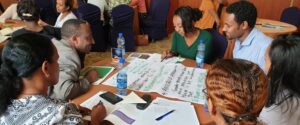Balancing information and participation: Reflections on learner-centred training
This is a guest post by Rachel McIntosh, Research Uptake Manager at the Department for International Development. Rachel writes about her recent participation in an INASP Pedagogy Skills workshop and how this has led her to reflect on her own skills and practices as a trainer.
I recently had the privilege of attending a pedagogy skills workshop in Ghana, organised by INASP’s Strengthening Research and Knowledge Systems programme, which is funded by DFID and Sida. The workshop participants were librarians working at Ghanaian university libraries. All of the librarians train others in one form or another. For example, one lady lectures on information literacy to 200 students at a time (this provided an interesting conundrum during the workshop session on seating layouts that support effective participation!). Many of the librarians provide training to first year students to build awareness of the library’s resources and skills in using them. The librarians also provide one-to-one training to library users as it is requested – particularly in using e-resources whose accessibility and popularity has improved in Ghanaian libraries over recent years. At the workshop it soon became evident that the training the librarians had provided previously tended to reflect the way that they themselves had been schooled/trained in the past, with relatively little participation from the learners. As the workshop progressed, I saw first-hand how the participants grew in their appreciation and practice of pedagogy skills.
My participation in the workshop made me reflect on my own training skills. I have attended similar workshops in the past and I would like to think that I deliver learner-centred participatory training. But as time went on, I realised that my appreciation for learner-centred training doesn’t always become a reality.
At the training we learnt how to plan a training session, developed participatory training techniques and considered how to manage the risk of disaster during a training session (which our own trainers demonstrated very ably when the electricity failed for a few hours!). This led me to ponder a question (which you might like to ponder yourself before reading on):
“If we are delivering a training session and are running out of time, what is the best activity to cut if we want good learning outcomes – should we cut our provision of information or participatory activities?”
I have experienced this situation many times before. The session just doesn’t go the way I had planned it. Maybe because I tried to cover too much in the session (poor planning). Or, because people are unpredictable, I might need to invest time in getting everyone up-to-speed or managing disruptive learners. Or perhaps the fire alarm goes off and I lose half an hour of valuable training time. So going back to my question, what should we do with the time we have left in the training session?
The most likely thing I would do is to forget the participatory aspects of the session in favour of simply downloading information to the learners. This is usually because:
a) I know I have valuable knowledge to share;
b) if I’m honest, I want to be acknowledged and respected for my expertise – how much I know and understand the issues – and what better way to demonstrate that than through an eloquent monologue!;
c) I usually have an objective around learners having greater understanding of the session’s topic. It is tempting to see this as a prerequisite for achieving the other session objectives. And the other objectives – the bits that usually require participation such as group work – are, after all, just fun ways to elaborate and reinforce my points, aren’t they?!
Yet for each of these reasons, there is a counter-argument:
a) “Valuable knowledge” is rather subjective. If we are really pushed for time we may be more likely to select material that makes us tick than the material that is likely to be most useful for the learners. And there is an important but subtle difference between knowledge and information. Knowledge can be viewed as internalised information. We receive or seek out information; if it is important to us and we give it value, it becomes part of our knowledge which we may draw on in the immediate or distant future.
By focusing on participatory tasks instead of imparting the content of our own brains (even if we need to provide a small amount of information to set up the task), we will most probably discover that a degree of relevant knowledge and common sense already exists in the learner/s. If it is a group session, the majority of learners are still likely to learn something new but it will probably be something more relevant to them than what I was going to impart.
b) The most influential and memorable trainers in my past were the ones that made me think rather than those who just spoon-fed me, as frustrating as that felt at the time. I can still remember key learning from sessions where trainers got me doing crazy things like running to one end of the room or another if I agreed or disagreed with each of a set of statements, or building a bridge out of newspaper (both of which make me wince as I write). I love a good lecture, so this just goes to show how although we each have preferred learning styles, taking learners out of their comfort zone and making them think and work things out for themselves can have an impact on learning outcomes.
c) Much of what we want to download in a training session can be read in a book or online. Should we not take advantage of the opportunity for us to interact with the learners and for learners to interact with each other? We could provide the basic information needed to introduce a participatory activity and point learners to other sources of information that they can read and reflect on after the session.
I am not suggesting that we should always prioritise participation over downloading information. Sometimes it will be appropriate to cut participatory activities in favour of delivering information, though hopefully we can encourage interaction when we do the latter. What I am suggesting is that sometimes our motivations and priorities are not always right and this can hinder optimal learning outcomes.
I have enjoyed the challenge of pondering this question. Of course, the proof of the pudding is in the eating. I would hope that anyone reading this who I train in the future will not be disruptive in the session on purpose to put me to the test! But I would like to think that when time is short and I need to think on my feet part way through a session, my priorities will be more learner-centred.




